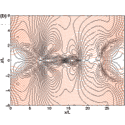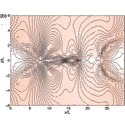Different routes for reconnection
Reconnection occurs in moving plasmas when magnetic field lines come together, snap, and reform. These events can release tremendous amounts of energy and researchers believe that magnetic reconnection may help trigger powerful solar flares and contribute to auroral phenomena in Earth’s ionosphere.
Despite extensive study, however, reconnection events remain puzzling. Reconnection occurs in very localized regions, so how can the energy release be magnified to large scales and operate quickly enough to explain observations of astrophysical events? In the 13 June issue of Physical Review Letters, Giovanni Lapenta of the Katholieke Universiteit Leuven in Belgium reports simulations of reconnection that reveal two different scenarios. In the first, called the Sweet-Parker process, reconnection occurs slowly and smoothly as laminar magnetic field lines merge in a local region, but then a second and faster reconnection mechanism is possible. In this scenario, reconnection is rapid and chaotic, with many small regions of reconnection occurring randomly. These chaotic islands of reconnection in turn create energetic plasma circulation patterns that increase the speed of reconnection.
Such two-stage events, where slow reconnection evolves into fast self-feeding turbulent reconnection, may explain very large-scale energy release in highly magnetized astrophysical plasmas, but more needs to be done to compare the simulations with observational data. - David Voss





